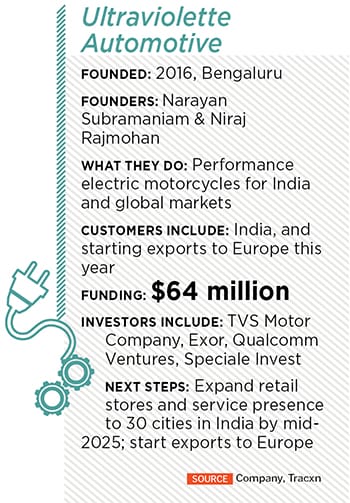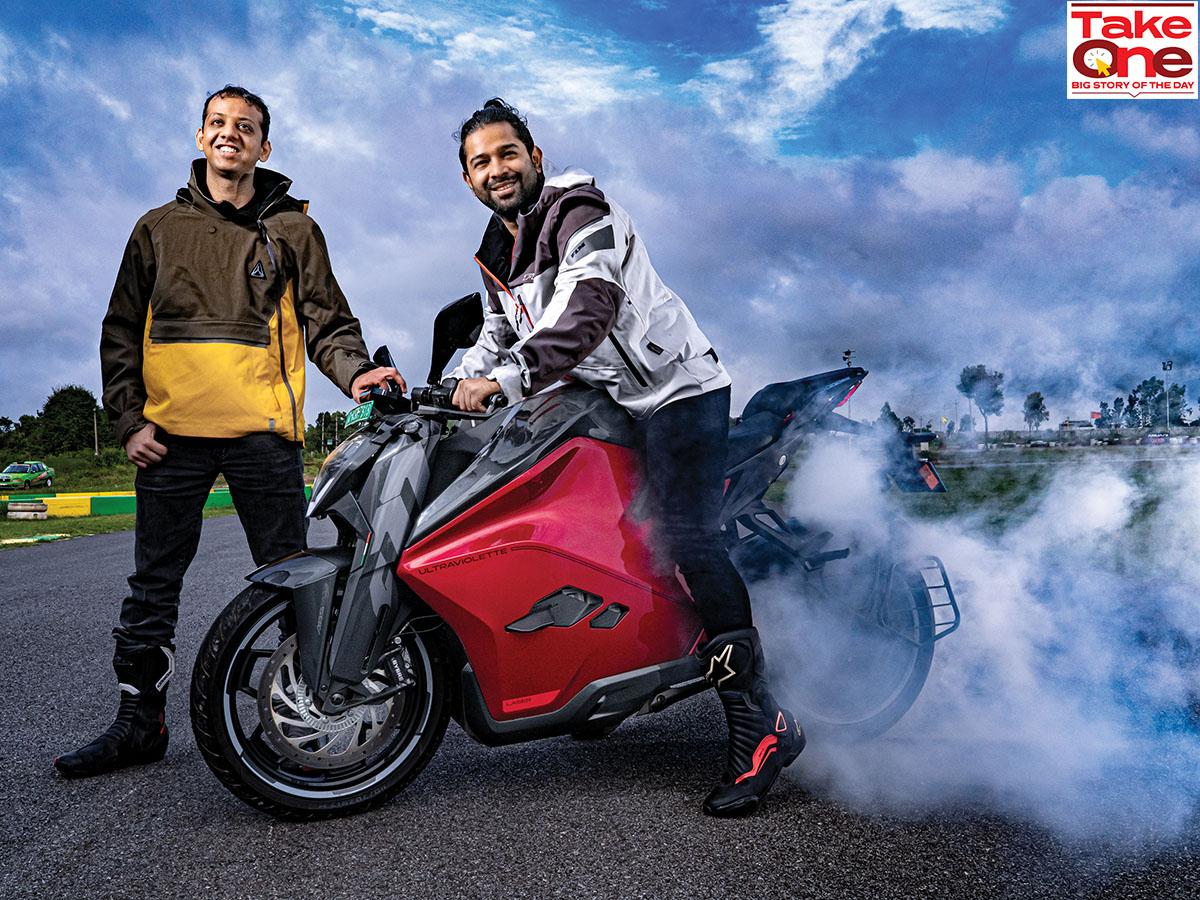
Niraj Rajmohan (left), co-founder and CTO, and Narayan Subramaniam, co-founder and CEO of Ultraviolette
Image: Selvaprakash Lakshmanan for Forbes India
This year, Narayan Subramaniam and Niraj Rajmohan and team Ultraviolette released the next iteration of their F77 electric performance motorcycle—the F77 Mach 2. With it, they announced three levels of traction control, and 10 levels of regenerative braking, a function that’s important to extracting more range from electric vehicles (EV).
The bike offers 40.2 horsepower, 100NM of torque, top speed of 155 kmph and a maximum of 323 km per charge. As with its predecessor, for the top specs, buyers need to choose the ‘Recon’ variant. The bikes are offered in two shades each of red and grey, one yellow, white, silver, a blue and a black.
“One of our fundamental innovations is the amount of energy we are able to recover through our systems,” Subramaniam tells Forbes India. “We are able to recover between 25 percent and 30 percent of the expended energy through regenerative itself.” In comparison, electric scooters today can recover 5 to 8 percent, he says.
Another new feature is a system called Dynamic Stability Control, which Subramaniam says is a world first “on any two-wheeler”. He explains it like this: When one slows down, braking can be mild, active or in panic. In the last case, the ABS (anti brake-locking system) wants to prevent locking of the wheels, while the regenerative system tries to actively slow down the vehicle.
Ultraviolette has developed a system that figures this out in real time and accords the correct hierarchy between the ABS and the regenerative function. “This hadn’t been done at all on any two-wheeler. We had to develop it for the first time,” he says.
 Subramaniam and Rajmohan started Ultraviolette Automotive in 2016, inspired by aerospace in the way they approached their design, they always like to say. Today they’re naming their showrooms ‘Space Stations’. They’ve expanded beyond Bengaluru, where the company is headquartered. They are now present in Pune, Ahmedabad, Hyderabad, Cochin, Vizag, and recently Nepal as well. By mid-next year, they expect to be in 30 cities in India. They’re also about to start exporting CBUs (completely built units) to Europe.
Subramaniam and Rajmohan started Ultraviolette Automotive in 2016, inspired by aerospace in the way they approached their design, they always like to say. Today they’re naming their showrooms ‘Space Stations’. They’ve expanded beyond Bengaluru, where the company is headquartered. They are now present in Pune, Ahmedabad, Hyderabad, Cochin, Vizag, and recently Nepal as well. By mid-next year, they expect to be in 30 cities in India. They’re also about to start exporting CBUs (completely built units) to Europe.
“Another important milestone is we have now been certified for sales across Europe,” Subramaniam says. The company is in talks with distributors to cover Germany, Spain, Turkey, Austria and Switzerland initially. Initially they expect to export from India, certainly through 2025, but they also will be able to quickly establish partnerships if local manufacturing in overseas markets is warranted, he says.
At home in India, they’ve made the effort to address specific concerns such as the viability of EV batteries with time and real-world usage.
Ultraviolette offers vehicle warranty of up to eight years or eight lakh kilometres, he says. The company decided to do this scientifically and demonstrate that the data validates the decision to offer such plans.
“We have our own fleet of vehicles which have each crossed 100,000 kilometres in real world testing”, which was done as accelerated testing over two to three years. When the vehicles were taken to ARAI (Automotive Research Association of India) for range re-certifications, they still showed a range of 304 km per full charge, which was about 95 percent of the original rating, he says.
“What we wanted to establish is that if the batteries are engineered right, a vehicle owner through the lifetime of ownership will not have any battery replacement concerns,” he says.
There are also safety features included, such as ‘Hill Hold’ that one usually finds in the mid- to higher-range cars, and a tyre pressure monitoring system. Ultraviolette has also introduced a module on the vehicle similar to home security systems where one is able to log various events.
Also read: What will it take for Maserati to succeed in India?
In the case of the bike, think in terms of someone touching the vehicle, causing it to fall, or towing it, and, of course, a crash. This security module will detect such instances and send alerts to the owner or set off an alarm.
“We took our time to get everything established in Bengaluru because when you’re working with multiple dealer partners, we need a certain level of predictability on both supply chain as well as the availability of after-sales services and spares.” The company has an R&D team of 200, another 100 staff in operations and about 200 contract staff involved in the assembly of batteries and the motorcycles.
The entrepreneurs are confident that they’ve now established the backend processes and an effective template for customer experience from a purchase and a brand experience standpoint.
The Indian market is well on its way to embracing electric two wheelers, Subramaniam says. “The adoption curve has been pretty rapid in India. EV awareness has grown exponentially.” Currently, there are more products in the lower-powered scooter segments because the technology is more commoditised, he says, and development cycles are faster. With higher performance segments, including in motorcycles, there’s more R&D involved and testing before vehicles can hit the market.
With the internal combustion engine two-wheelers, the market comprises 60 percent motorcycles and about 30 percent scooters, he says. “And we may see a similar split evolve in EVs,” he says. Although scooters have taken the lead in terms of volumes, as companies such as Ultraviolette bring higher-powered vehicles to fore, “the adoption curve will ramp up”, he says. Overall, in a year’s time, Ultraviolette is targeting sales “in excess of 1,000 vehicles a month”, he says.
(This story appears in the 01 November, 2024 issue
of Forbes India. To visit our Archives, click here.)
